Qualcomm Snapdragon 888 Performance Preview: Big Gains For Next-Gen Android Flagships
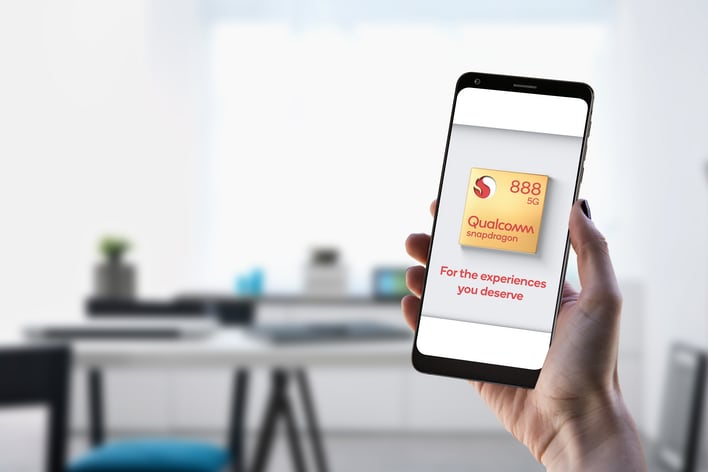
At the time of its announcement, Qualcomm gave us some high level specs on the Snapdragon 888, including the fact that it has a single prime core based on the new Arm Cortex-X1 microarchitecture clocked at 2.84GHz, three performance cores clocked at 2.42GHz, and four efficiency cores clocked at 1.8GHz. Qualcomm claims its new Kryo 680 CPU architecture delivers a 25 percent uplift in performance over its predecessor, while its Adreno 660 GPU is dialed in for a 35 percent gain over the previous-gen Qualcomm Adreno 650 GPU. In addition, Qualcomm made further claims of significantly better performance in machine learning (AI) workloads, as well as major advancements in computational photography.
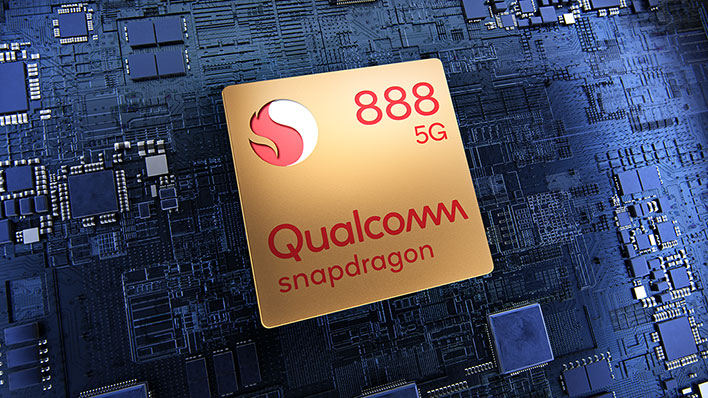
Although we would have liked to have gotten our hands on an actual Snapdragon 888 reference phone to do our own testing, that simply wasn't in the cards for now. However, today Qualcomm has delivered the next best thing, which was to send over its own internal figures from benchmarks that it ran with a reference design Snapdragon 888 smartphone.
According to the company, this reference smartphone paired the Snapdragon 888 with 12GB of LPDDR5 memory, 512GB of UFS 3.1 storage, a 6.65-inch FHD+ (2340x1080) display, and a 3,790 mAh battery. Qualcomm says that it ran each benchmark three times and took an average of the runs, and those numbers are what we have presented for you below.
Again, please note, the Snapdragon 888 scores listed below are not representative of our own internal test results but rather were provided by Qualcomm. All other device scores are actual internal HotHardware test results from currently shipping retail devices.
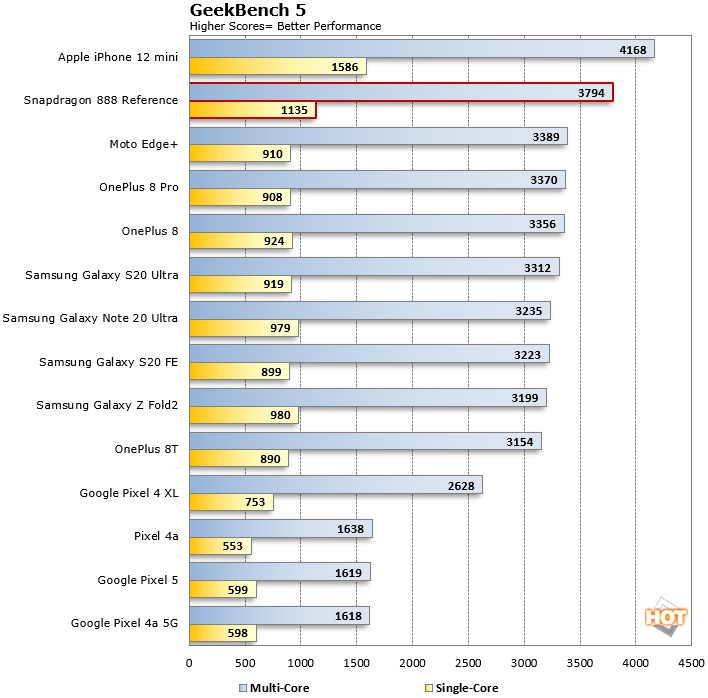
In Geekbench, the Snapdragon 888 shows a healthy ~ 23 percent gain over the Snapdragon 865 in the single-core benchmark. The performance increase in the multi-core score is smaller, however, coming in at around 12 - 15 percent. Meanwhile, Apple's A14 Bionic in the iPhone 12 mini demonstrates about a 10% multicore lead and a major ~ 40% single-core edge.
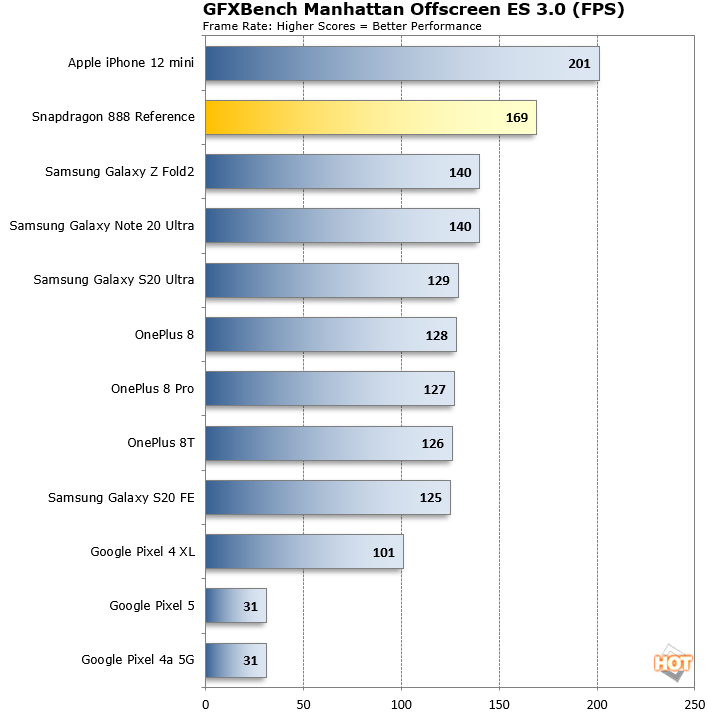
With GFXBench, we see roughly a 21 percent uplift in performance for the Snapdragon 888's Adreno 660 GPU compared to the Adreno 650 nestled inside the Snapdragon 865. But once again, the GPU in the A14 Bionic flexes its muscle with a 19 percent higher result than even the mighty Snapdragon 888.
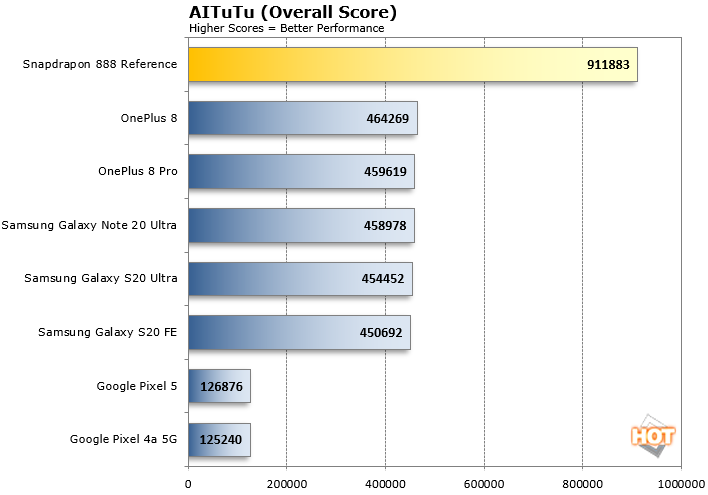
AITuTu was an absolute smoke show benchmark for the Snapdragon 888, thanks to its new Hexagon 780 AI processor. The Hexagon 780 delivers 26 TOPS, a 73 percent improvement over the previous generation, and we see in AITuTu a score that is roughly double that of the AI engine in Snapdragon 865. We should note that this acceleration will help in a myriad of application use cases from AI-assisted recommendation engines, to computational photography and many others.
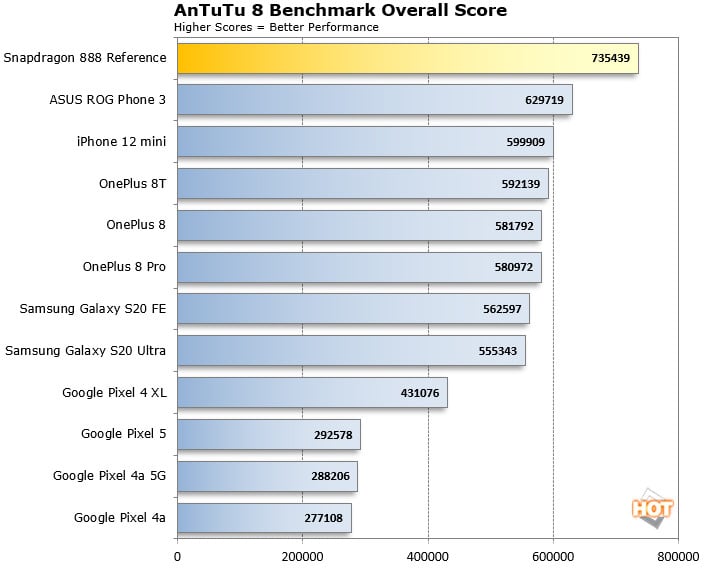
Our last comparative benchmark focuses on AnTuTu, which sees the Snapdragon 888 deliver a 24 percent improvement over the OnePlus 8T. The Snapdragon 888 even managed to outpace the mighty ASUS ROG Phone 3. Update - 12/19/20: We've added the iPhone 12 mini for reference in these scores, though we didn't have an opportunity to run it at the time of first publication. What's interesting here is that the iPhone actually loses in the overall score, though since Qualcomm didn't provide sub-test details for CPU, GPU, Memory and UX scores, only the overall score is represented here. Of note is that the iPhone 12 mini actually slots in just behind or equivalent to the Snapdragon 865 phones in the sub-tests scores. Regardless, we look forward to testing Snapdragon 888-powered OEM production smartphones when they become available in Q1 2021.
Again, these aren't results that we personally pulled from the Snapdragon 888, and we've just plugged the numbers Qualcomm sent into our database of results for comparison purposes. You can see the full table of data that Qualcomm provided below, along with a demo video the company prepared as well.

It's important to note that, again, these scores are from a very early reference design device and not a retail shipping product. Performance is likely to improve over time as smartphone OEMs tune and optimize their own designs and devices.
Even with these early benchmarks, we can see that Qualcomm has made some great improvements in performance compared to last year's Android flagships. However, it looks as though there's still some daylight between the Snapdragon 888 and Apple's latest 5nm A14 Bionic, when it comes to CPU and GPU performance. However, we're eager to see what kind of efficiency gains can be extracted with Snapdragon 888, thanks to the new 5nm manufacturing process node employed by Qualcomm for its latest silicon, and the fact that its Snapdragon X60 5G modem is now fully integrated into the Snapdragon 888 SoC, rather than a discrete chip.
With that being said, we won't declare any victors yet, until we start working with retail smartphones in the new year. And if the rumor mill is right, we might not have to wait very long, as the Samsung Galaxy S21 family is likely to be the first out of the gate with the Snapdragon 888 here in the United States, perhaps sometime in mid-January.

